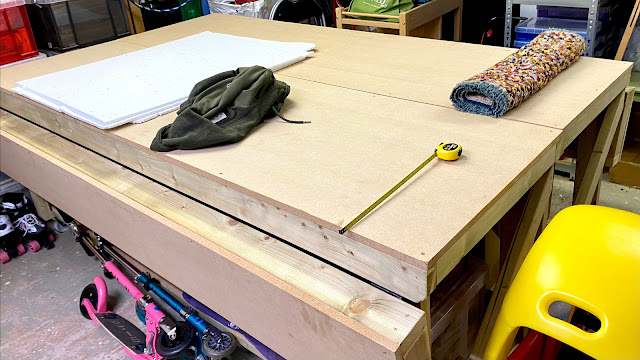In this blog post I explain how I have tried to ‘turn-the-tables’ on 2020 and bring wargaming home!
 |
| The very thing that I have been missing - classic 28mm action on the table top. |
Needing to ‘social distance during the pandemic must have affected every wargamer’s hobbying by now. For me it has curtailed regular club gaming. Actually playing the games may only be a small proportion of my overall hobby time but it is a pretty critical part. I think a lot of my motivation to paint etc. comes from the thought of getting the miniatures on to the tabletop and playing games. I have been missing tabletop action more and more as the months have gone by.
I started thinking about the possibility of setting up a wargames table at home. My ideal would be a 8’ x 6’ surface. I worked out that I could fit something of this size in our garage, previously used for rather disorganised storage. Following agreement with the family, the garage was duly tidied up (including many trips to the council recycling centre!) and two workbench style tables purchased. The tables I found are from Arbor Garden Solutions that I discovered while googling for tables.
 |
| The delivered, flat pack, components. |
Their extendable workbench (https://arborgardensolutions.co.uk/wooden-mdf-top-extendable.html) looked like it would provide the right combination of sturdiness, space, and adaptability. I had no experience of this company, but the online reviews I could find looked promising, and so I jumped in and ordered two 8’ x 2’ work benches (with 1’ extending wings, and wheels). They arrived in about a week (despite their website’s warning of potential Covid related delays) in their flat pack form.
 |
| All screws provided, but you’ll need something to screw them in with! |
Arbor have some super useful videos showing how their products are put together. With these, and my very basic DIY skills, I was able to build the two workbenches in an hour or so. (These are sturdy items and so I did need a hand to turn the finished tables the right way up!). With the extendable sections collapsed, there is still plenty of room to move around the tables. The storage underneath the worktop surface was very helpful, and the wheels make the tables easy to move about if need be (as well as making the tables a bit taller, and therefor easier on the old back!).
 |
| Table surrounded with the inevitable family ‘stuff’ that needed to be allowed for. |
With the extendable sections up, and the two workbenches together, there is a very useful 2400mm x 2000mm flat surface. (Note that although advertised using Imperial ‘feet’, the workbenches are, I suppose, made from metric materials and therefore end up a bit bigger.) The family all approve, and they are now all thinking of lots of other hobby related activities that they can also use this large table space for. All good, as it helps realise the final ‘business case’!
 |
| The extended surface. |
 |
| Wings down, still a useful 8’ x 4’ 6” surface. |
Half-term holiday at home provided the ideal opportunity to try out some games on the new ‘table’. I have had my 28mm TYW Swedish and Imperial armies out, and played a couple of very enjoyable games, both solo and with the family. Being able to leave a game out and return to it at a later time is a great advantage. I am also looking forward to being able to try out some other pike and shot rules systems, on my own, using full size armies. This sort of activity is never a good use of time at the club, but will suit a home games table very well. I may even be able to photograph a couple of battle reports for the blog.
 |
| Terrain and figures getting some use at home! |
So, while I still look forward to returning to the fun of club gaming, I now have another outlet for tabletop gaming.
Until next time!
Andy @ FoGH.






















